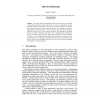Free Online Productivity Tools
i2Speak
i2Symbol
i2OCR
iTex2Img
iWeb2Print
iWeb2Shot
i2Type
iPdf2Split
iPdf2Merge
i2Bopomofo
i2Arabic
i2Style
i2Image
i2PDF
iLatex2Rtf
Sci2ools
99
Voted
CASDMKM
2004
Springer
2004
Springer
Data Set Balancing
This paper conducts experiments with three skewed data sets, seeking to demonstrate problems when skewed data is used, and identifying counter problems when data is balanced. The basic data mining algorithms of decision tree, regression-based, and neural network models are considered, using both categorical and continuous data. Two of the data sets have binary outcomes, while the third has a set of four possible outcomes. Key findings are that when the data is highly unbalanced, algorithms tend to degenerate by assigning all cases to the most common out come. When data is balanced, accuracy rates tend to decline. If data is balanced, that reduces the training set size, and can lead to the degeneracy of model failure through omission of cases encountered in the test set. Decision tree algorithms were found to be the most robust with respect to the degree of balancing applied.
Related Content
| Added | 01 Jul 2010 |
| Updated | 01 Jul 2010 |
| Type | Conference |
| Year | 2004 |
| Where | CASDMKM |
| Authors | David L. Olson |
Comments (0)

